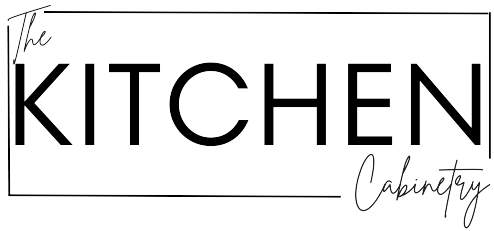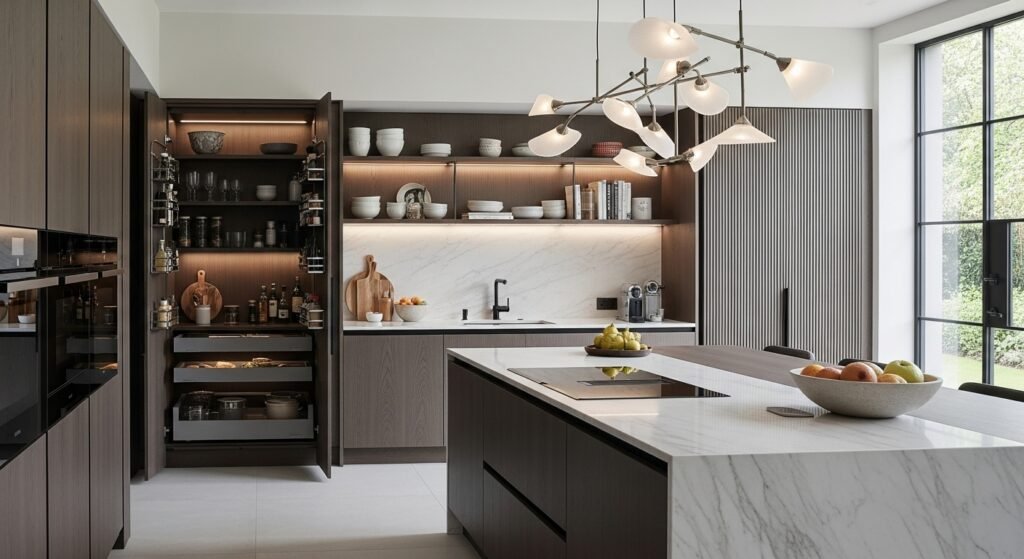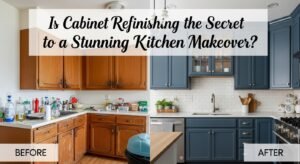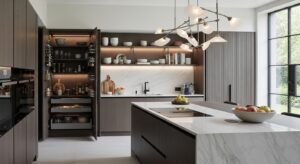As homeowners continue to seek innovative ways to enhance their living spaces, the realm of kitchen cabinet design has witnessed some exciting developments. From minimalist aesthetics to bold colour choices, trends are evolving to reflect personal style and functionality. This shift allows for not only aesthetics but also increased efficiency in one of the home’s most utilised areas. Therefore, embracing these latest trends can significantly transform your kitchen, making it a perfect blend of beauty and practicality.
Table of Contents
ToggleMain Points
- Exploration of minimalist designs and their impact on space.
- Incorporation of sustainable materials in kitchen cabinetry.
- The rise of dual-tone cabinetry for visual interest.
- Smart storage solutions to enhance functionality.
- Customisation options for unique personal flair.
1. Embracing Minimalism: The Rise of Sleek and Simple Cabinet Designs
In recent years, the trend of embracing minimalism has transformed the landscape of kitchen cabinet design. Homeowners increasingly gravitate towards sleek, simple lines that exude elegance. Such designs not only promote a sense of calm but also highlight the beauty of everyday essentials. Therefore, many are opting for cabinets that boast functionality without unnecessary embellishments. This minimalist approach encourages a decluttered atmosphere, making kitchens feel more spacious and inviting. Could this be the new norm for contemporary homes?
Modern Innovations in Kitchen Cabinet Design: Exploring Top Brands
The world of kitchen cabinet design has seen significant evolution, particularly with prominent brands like House of Cabinet and Cabinets House leading the way. Additionally, companies such as Forevermark and Fabuwood have garnered attention, offering innovative solutions that blend form and function. With a growing emphasis on customization, these brands cater to various tastes and preferences. Consequently, homeowners now have the opportunity to redefine their spaces, ensuring their cabinets reflect both style and practicality while addressing specific needs.
2. Biophilic Design in Kitchens: Integrating Nature with Cabinet Choices
Biophilic design in kitchens embraces nature, creating a harmonious environment through carefully selected cabinet choices. By incorporating materials like reclaimed wood or natural finishes, homeowner choices transcend ordinary kitchen cabinet design. Elements such as plants or natural colors can complement your cabinets, fostering a calming ambiance. Therefore, it’s essential to consider how these choices impact not just aesthetics, but also the overall functionality of the space. In my opinion, the right balance can elevate your cooking experience.
3. The Impact of Smart Technology on Modern Kitchen Cabinet Solutions
Smart technology profoundly influences modern kitchen cabinet design, enhancing functionality and convenience. With the integration of automated features, homeowners can now control lighting and storage systems effortlessly. Additionally, innovations such as motion sensors and smart locks streamline access, making daily tasks more efficient. However, the balance between aesthetic appeal and high-tech features remains a challenge. Only time will reveal how these advancements reshape our understanding of kitchen cabinet design, creating spaces that blend style and practicality.
4. Colour Palettes That Pop: Trends in Vibrant and Muted Cabinet Finishes
In the evolving landscape of kitchen cabinet design, colour palettes play a pivotal role. Vibrant hues can create an exhilarating atmosphere, inviting a sense of energy, whereas muted tones offer calm sophistication. Currently, striking combinations like deep navy paired with soft beige are gaining traction, providing both contrast and harmony. However, choosing the right finish involves personal taste, as these colours can drastically alter the perceived space, influencing ambiance and mood within the kitchen.
5. Open Shelving vs. Closed Cabinets: Finding the Right Balance in Your Kitchen
In today’s kitchen cabinet design, the choice between open shelving and closed cabinets often sparks debate among homeowners. Open shelving creates an airy feel, allowing you to display beautiful dishware, yet it can also attract dust and clutter. Closed cabinets, on the other hand, provide a more streamlined appearance, concealing messes but limiting accessibility to items. Therefore, striking the right balance ultimately depends on your personal preferences and lifestyle needs, shaping your unique kitchen cabinet design.
Considerations for Your Space
When deciding, think about functionality, aesthetics, and the overall vibe you want in your kitchen. Some opt for a harmonious blend of both styles in their kitchen cabinet design, catering to both display and practicality.
6. Sustainable Materials: Eco-Friendly Cabinetry Trends Transforming Spaces
As our awareness of environmental impact grows, eco-friendly materials are reshaping kitchen cabinet design. Innovations in sustainable woods and recycled materials not only add character to spaces but also contribute to a healthier planet. However, the charm of these materials may vary, leaving homeowners to ponder their choices. Kitchen cabinet design must balance aesthetics with sustainability, often leading to delightful surprises in both style and functionality. After all, every choice can tell a story.
“Sustainable design is not just a trend; it’s a necessity for our future.”
Ultimately, opting for sustainable cabinetry could redefine your home environment, showcasing an aesthetic that resonates with conscientious living.
7. Customization and Personalization: Tailoring Cabinets to Suit Your Lifestyle
Incorporating customization into your kitchen cabinet design enhances both functionality and aesthetics. Personalised cabinets can reflect your unique taste while catering to your specific needs. Consider how you use your kitchen; for example, do you need extra storage for seldom-used appliances, or seek a layout that maximizes accessibility? Options include:
- Material: Choose between wood, laminate, or metal to influence style and durability.
- Finish: Select colours or textures that harmonize with your home’s overall design.
- Configuration: Opt for open shelving, deep drawers, or integrated lighting for a practical yet striking look.
Such thoughtful decisions in your kitchen cabinet design ultimately lead to a space that not only suits your lifestyle but also feels uniquely yours.
Furthermore, consider potential future changes, as adapting your cabinets can help accommodate evolving needs. Your kitchen should truly be a reflection of you.
Conclusion
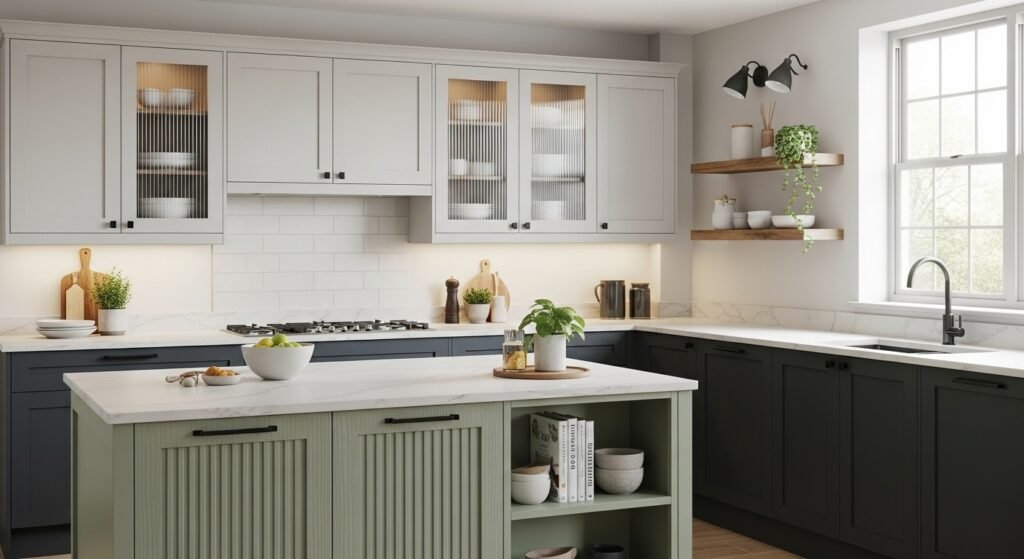
In conclusion, a well-thought-out kitchen cabinet design can significantly enhance the functionality and aesthetic appeal of your space. By considering factors such as materials, layout, and colour schemes, you create an environment that is both practical and visually appealing. Therefore, taking the time to plan and personalise your cabinets ensures they meet your needs and reflect your style. Ultimately, investing in thoughtful design can transform your kitchen into a warm and inviting heart of the home, making every meal and gathering an even more enjoyable experience.
Frequently Asked Questions
What are the latest trends in kitchen cabinet design?
Some of the latest trends in kitchen cabinet design include minimalist styles, open shelving, two-toned cabinets, and sustainable materials. Modern designs often incorporate handle-less doors and smart storage solutions.
How do I choose the right colour for my kitchen cabinets?
When choosing a colour for your kitchen cabinets, consider the overall style of your kitchen, the size of the space, and the amount of natural light it receives. Neutral colours like whites and greys are versatile, while darker shades can create a dramatic effect.
Are custom cabinets worth the investment?
Custom cabinets can be worth the investment if you have specific design needs or want to maximise storage in unusual spaces. They allow for greater flexibility in style, size, and materials compared to pre-fabricated options.
What materials are best for kitchen cabinets?
The best materials for kitchen cabinets include solid wood for durability and aesthetic appeal, plywood for a balance of strength and cost, and MDF for a smooth, paintable surface. Laminate is also a popular choice for a sleek, modern look.
How can I improve the storage in my kitchen cabinets?
To improve storage in your kitchen cabinets, consider installing pull-out shelves, lazy Susans, drawer dividers, and vertical dividers for baking sheets. Using clear containers for smaller items can also maximise space and improve organisation.
